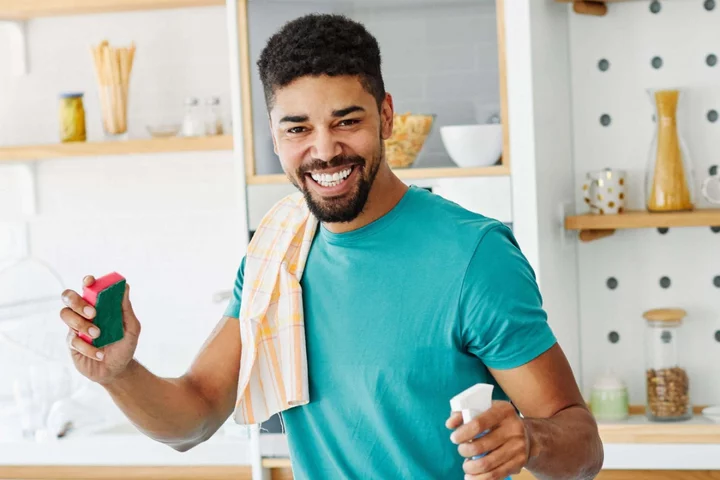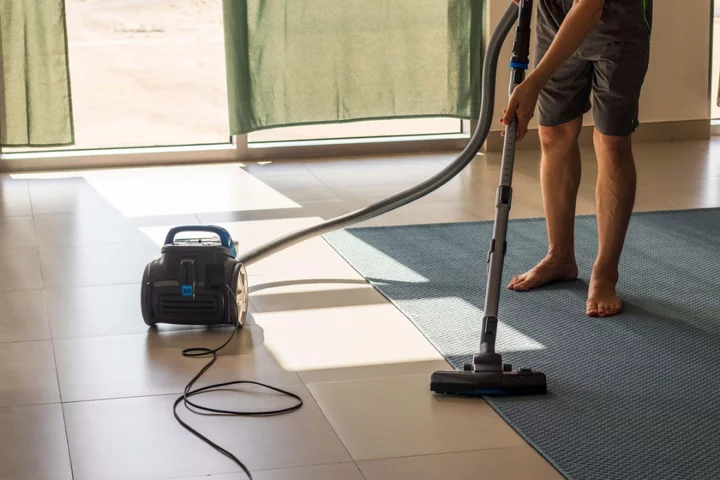
Passenger uses AirTag to track the bike his airline lost
When your luggage goes missing, it's bad enough. Tackling the start of your vacation without your clothes or toiletries? It's not something most of us want to do. But when your luggage itself is the reason you're traveling in the first place, it gets considerably worse.
1970-01-01 08:00

Adidas to release second batch of Yeezy sneakers after breakup with Ye
Adidas is releasing a second batch of high-end Yeezy sneakers after cutting ties with rapper Ye, formerly known as Kanye West
1970-01-01 08:00

Experts reveal the most unhygienic things in your kitchen – and how to get them clean
It’s likely there are countless things in your kitchen which look clean, but actually, they’re filthy. Could your dishcloths be making you sick? When was the last time you washed your tea towels? And do we really need to bleach the sink more than once a month? We asked an expert to find out. Knobs, door handles, and buttons The buttons and dials on your kitchen appliances could be a germ-fest. “People often neglect to clean these areas of the kitchen,” says Danielle Mason, a cleaning content creator – or ‘cleanfluencer’ – who creates tutorials and videos on TikTok and Instagram. “Most of the time, they don’t think it is important, but as you’re commonly handling raw meat and food, it’s extremely important to keep these areas clean, due to cross-contamination. “Always sanitise with a cloth – I like to do this with Zoflora, as it leaves a great smell afterwards, and kills bacteria from dirty fingers.” Cloths If what you clean with isn’t clean, chances are, your kitchen isn’t either. “I always leave my cloth to soak in bleach before going to bed every night,” says Mason. “This enables a new start in the morning with no bacteria. Also, make sure you’re replacing the cloths – I would suggest a new one every two weeks, whilst still bleaching every night. And make sure you’re not using this cloth on anything other than the kitchen, as you do not want to cross-contaminate.” Sponges Mason stresses sponges are unhygienic, as they’re constantly damp and can carry E. coli. “People tend not to use sponges, as they carry so many more germs, and even putting them in the microwave will not kill all of them. Avoid a sponge where possible.” Dish towels Dish towels and tea towels may not be changed anywhere near often enough. “You should have one for every day of the week, as they carry so many bacteria and germs, which get spread across the kitchen. If you’re drying pots and pans, and then wiping down your surfaces, it’s not good,” she says. Chopping boards Chopping boards – particularly wooden ones – could be a haven for bacteria. “You should have a different colour for different types of food, one for meat, fruit, and other foods,” advises Mason. “The best way to clean them is in a dishwasher, as it’s good to get rid of all the germs due to the very high heat. If you don’t like the dishwasher, then boil the kettle water and leave the chopping boards to soak in it. I use a steam cleaner on mine, as it kills 99.9% bacteria and there are no chemicals.” It is best to avoid wooden chopping boards altogether, as these cleaning methods may damage them. Kitchen sink “This is a massive breeder of bacteria and grime; a distinct microbiome is found in sinks. “The plumbing area found beneath sinks revealed microbial communities dominated by a group of bacteria called Proteobacteria. This phylum includes pathogens such as Salmonella and E. coli, which can cause serious disease,” Mason shares. “I’ve always been taught never to wash my hands in the sink, and to never throw dirty water down the sink. You wash your cups and plates in the sink and prepare food, so it should always be kept clean, and nothing from outside the kitchen should cross-contaminate that. For example, never wash your floors and put dirty water in your kitchen sink, always throw it down the toilet.” How do you possibly clean the inside of your sink and drains? “Baking soda and vinegar is the best way to clean your sink out, or bleach, but you must be careful with bleach, as it can stay in the bottom of your sink, depending on the material it’s made of. I clean my sink out every day.” Pipes and cupboards around your sink could be leading you to have a rodent problem. “You can prevent mice and rodents from entering the kitchen by covering any small crevices or cracks. It is also important to repair leaks as soon as they happen, as they can come through the pipes,” she says. Fridges “Deep clean [your fridge] every two months. A normal cleaning – the wiping of shelves – should be done every other day with soapy water. For any bad smells, use baking soda, which will absorb the smell from the fridge,” Mason continues. “The fridge is a breeding ground for salmonella, E. Coli and other bacteria.” Bins Where you throw your waste away could be a breeding ground for germs. “Make sure you keep [outdoor] rubbish bins away from your house, and make sure you empty your bin as soon as it’s full,” advises Mason. “I personally do not keep a bin in the kitchen, I use a bag and I take that out by the end of the day, but if you are using a bin, make sure you bleach it with hot kettle water, to keep it smelling fresh.” Read More This is why you keep waking up at 4am – and what you can do about it TV chef James Martin reveals cancer diagnosis in apology over ‘bullying’ allegations Bursts of activity that make you huff and puff ‘linked to reduced cancer risk’ Charity boss speaks out over ‘traumatic’ encounter with royal aide Ukraine war’s heaviest fight rages in east - follow live
1970-01-01 08:00

Norway Tourism Gets Boost From Foreigners on Krone
Norwegian tourism is thriving after a weaker krone made the famously expensive Nordic country cheaper to visit and
1970-01-01 08:00

Bursts of activity that make you huff and puff ‘linked to reduced cancer risk’
Short bursts of daily activity that make you huff and puff – such as playing high-energy games with children – could help reduce the risk of cancer, research suggests. According to the study, a total of just four-and-a-half minutes of vigorous activity – done in bursts of around one minute each – during daily tasks could reduce the overall risk of cancer by 18 per cent, and the risk of some cancers linked to physical activity by up to 32 per cent. Other activities could include vigorous housework, carrying heavy shopping around the supermarket, or bursts of power walking. Lead author Professor Emmanuel Stamatakis, of the Charles Perkins Centre, University of Sydney, Australia, said: “We know the majority of middle-aged people don’t regularly exercise, which puts them at increased cancer risk, but it’s only through the advent of wearable technology like activity trackers that we are able to look at the impact of short bursts of incidental physical activity done as part of daily living. “It’s quite remarkable to see that upping the intensity of daily tasks for as little as four to five minutes a day, done in short bursts of around one minute each, is linked to an overall reduction in cancer risk by up to 18 per cent, and up to 32 per cent for cancer types linked to physical activity.” Cancer types linked to physical activity are those where not exercising increases the risk of developing the disease. The cancers associated with physical activity included liver, lung, kidney, gastric cardia (a type of stomach cancer), endometrial, myeloid leukaemia, myeloma, colorectal, head and neck, bladder, breast and esophageal adenocarcinoma (cancer of the oesophagus). Published in Jama Oncology, the study used data from wearable devices to track the daily activity of more than 22,000 people who do not exercise. Researchers then followed the group’s clinical health records for close to seven years to monitor for cancer. They found that as few as four to five minutes of vigorous intermittent lifestyle physical activity (Vilpa) was associated with a substantially lower cancer risk compared with those who undertook no Vilpa. Vilpa was coined by researchers at the University of Sydney’s Charles Perkins Centre to describe the very short bursts of activity – around one minute each – we do with gusto each day. Vilpa is a bit like applying the principles of high-intensity interval training (HIIT) to your everyday life Professor Emmanuel Stamatakis, University of Sydney Prof Stamatakis said: “Vilpa is a bit like applying the principles of high-intensity interval training (HIIT) to your everyday life.” He added that adults who do not exercise are at increased risk of developing certain cancers such as breast, endometrial or colon. But, until recently, experts were not able to measure the impact of less structured forms of vigorous physical activity. In the study sample of 22,398 people with an average age of 62 who did not exercise in their leisure time, the researchers found 2,356 new cases of cancer (1,084 in physical activity-related cancer) over an average follow-up of 6.7 years. They found that a minimum of around 3.5 minutes of daily Vilpa was associated with up to an 18% reduction in cancer incidence, compared with no Vilpa, while 4.5 minutes of daily Vilpa was associated with up to a 32% reduction in the risk of cancers linked to physical activity. The researchers used data from the UK Biobank Accelerometry Sub Study and only included people who reported no leisure time exercise and no regular recreational walks. Read More TV chef James Martin reveals cancer diagnosis in apology over ‘bullying’ allegations Men have a problem – and it won’t be solved by either Andrew Tate or Caitlin Moran Husband fired from family business after wife roleplayed with reborn dolls
1970-01-01 08:00

Beauty salon twist offers new perspective for art exhibition
A new art exhibition that has been made to look like a beauty salon where viewers are invited to look at works while sitting on salon chairs is set to open in Edinburgh. American artist Christian Noelle Charles launches the show on Friday at Edinburgh Printmakers. What A Feeling Act 1 will run until September 17. Artworks are in place of salon mirrors, and a radio will play excerpts of conversations with the artist. Ms Charles said she wanted to create a place of “relaxation and security” and a “new way of seeing”. She said: “I grew up going to beauty salons. I have always got my hair done since I was a kid. And I wanted to create a place of relaxation, security, that sense of getting ready is like the whole social aspect of it. “Creating these types of sets and installations change the perception of how people should look at art and also just feel relaxed in the space instead of analysing it too much.” Ms Charles composed a series of screenprints that explore and convey the gestures of being judged, analysed, and satisfied within a format of salon. Some examples of these gestures are hand crossing, lowering the glasses and tapping of the fingers. Ms Charles added: “As a black American, I was raised through the sense of gathering where barbershops and beauty salons were a centre of community and neighbourhood. “I feel like it is a good hybrid place to meet different cultures. In terms of black community in the African diaspora, salons were places of gathering that would do beauty or nails and was essential in terms of understanding one another, making sure that we look our best and what our culture represents from that. “Also, the idea of the beauty salon was a younger and modern take on that sense of the salon when it comes to showcasing paintings or prints in a specific way. It’s a pun on ‘The Salon’ within a beauty salon. “Since the work that I’ve been doing has been focused on getting ready and beauty and the essence of black women and how hard they work.” Ms Charles currently lives in Glasgow after studying for a masters degree at Glasgow School of Art. She is originally from Syracuse in New York. Read More Charity boss speaks out over ‘traumatic’ encounter with royal aide Ukraine war’s heaviest fight rages in east - follow live Bursts of activity that make you huff and puff ‘linked to reduced cancer risk’ Study uncovers what nap times reveal about young children’s brain development New outfits in Highland dress collection help museum tell the story of modern tartan
1970-01-01 08:00

New outfits in Highland dress collection help museum tell the story of modern tartan
National Museums Scotland has acquired eight outfits from contemporary Highland dress designers in a bid to tell the story of tartan in the 21st century. They have been added to the national collection of Highland dress, which charts how it has evolved since the 17th century. The acquisitions mark the culmination of a five-year project supported by the William Grant Foundation. A new online hub is launching on Friday, offering detailed images and descriptions of the latest acquisitions along with three films featuring interviews with designers and makers. The collection now includes modern designers like Prickly Thistle and Acme Atelier. The foundation’s research fellow Rosie Waine said they show how Highland dress is being adapted to the modern day. She said: “There is a perception that Highland dress never changes, but through working with contemporary makers, this project highlights a flourishing living tradition that continues to adapt and evolve. “These new acquisitions showcase incredibly skilled makers and production from across the country. “They join our existing collection to provide a comprehensive timeline of Highland dress from the 17th century to the modern day, highlighting its role as an icon of an ever-changing Scotland.” Read More Charity boss speaks out over ‘traumatic’ encounter with royal aide Ukraine war’s heaviest fight rages in east - follow live
1970-01-01 08:00

Study uncovers what nap times reveal about young children’s brain development
Babies and toddlers who nap a lot may have smaller vocabularies and poorer memory and thinking skills, research suggests. Parents and guardians all over the world worry about their children getting either too little or too much sleep. But a new study reveals that some children are better at consolidating information during sleep, so they nap less frequently. Those with fewer words and poorer cognitive skills need to nap more frequently, the researchers found. Young children will naturally nap for as long as they need and they should be allowed to do just that Dr Teodora Gliga, University of East Anglia However, the findings suggest that reducing naps for these children will not improve brain development, and that they should be allowed to nap as frequently and for as long as they need. Lead researcher Dr Teodora Gliga, from the University of East Anglia (UEA), said: “There is a lot of parental anxiety around sleep. “Parents worry that their kids don’t nap as much as expected for their age – or nap too frequently and for too long. “But our research shows that how frequently a child naps reflects their individual cognitive need. “Some are more efficient at consolidating information during sleep, so they nap less frequently. “Children with smaller vocabularies or a lower score in a measure of executive function nap more frequently.” She added: “Young children will naturally nap for as long as they need and they should be allowed to do just that.” The research team studied 463 infants aged between eight months and three years during lockdown in 2020. What we found is that the structure of daytime sleep is an indicator of cognitive development Dr Teodora Gliga, University of East Anglia Parents were asked about their children’s sleep patterns, their ability to focus on a task, keep information in their memory, and the number of words that they understood and could say. They also asked parents about their socioeconomic status – including their postcode, income, and education – and about the amount of screen time and outdoor activities their child engaged in. Dr Gliga said: “Lockdown gave us an opportunity to study children’s intrinsic sleep needs because when children are in childcare, they rarely nap as much as they need to. “What we found is that the structure of daytime sleep is an indicator of cognitive development. “Infants with more frequent but shorter naps than expected for their age had smaller vocabularies, and worse cognitive function. “We also found that this negative association between vocabulary and frequency of naps was stronger in older children.” She added that although the majority of parents reported that lockdown did not impact their children’s sleep, parents from lower socioeconomic backgrounds were more likely to report a worsening in sleep. Caregivers should use a child’s mental age and not chronological age to ascertain a child’s sleep needs Dr Teodora Gliga, University of East Anglia “Screen time increased during lockdown and outdoor activities decreased but these did not explain differences in children’s sleep,” Dr Gliga said. She continued: “Our findings suggest that children have different sleep needs – some children may drop naps earlier because they don’t need them anymore. “Others may still need to nap past three years of age. “In the UK, preschools enrolling three to five-year-olds have no provisions for napping. “Caregivers should use a child’s mental age and not chronological age to ascertain a child’s sleep needs.” The study, published in the JCPP Advances journal, was led by UEA in collaboration with researchers at the University of Oxford, Oxford Brookes University, the University of Leeds and the University of Warwick. It was funded by the Economic and Social Research Council (ESRC). Read More Charity boss speaks out over ‘traumatic’ encounter with royal aide Ukraine war’s heaviest fight rages in east - follow live Bursts of activity that make you huff and puff ‘linked to reduced cancer risk’ New outfits in Highland dress collection help museum tell the story of modern tartan 5 expert-approved ways to stop your hair colour fading this summer
1970-01-01 08:00

5 expert-approved ways to stop your hair colour fading this summer
Sun, sea and swimming pools may be the key ingredients for a fantastic summer holiday, but when it comes to hair colour maintenance, it’s a different story. UV rays, salt water and chlorine all have the power to turn rich brunette to mousy brown, ravishing red to sad salmon pink, and platinum blonde to yucky yellow. That’s why protecting your hair is so important during the sunnier months, whether you’re at home or on holiday abroad. Here, hair experts offer their advice on how to stop your hair colour from fading in the sun… 1. Use sun protection “The main reason why your colour fades in the summer is due to UV rays stripping away colour, especially if your hair is colour treated,” says Keiko Mizuno, education lead at Living Proof UK. “Naturally dark and light hair can get stripped from the sun too as UV rays lift all pigment, but it is more visible on lighter hair as blonde hair has less pigment compared to brunette hair.” Keeping your hair hydrated before you go out in the sun is the first step to lock in your colour. “Apply leave-in conditioner to repair and deeply nourish dry, brittle and dull hair, or create your own shade with a hat or parasol,” says Michael Kent, hair stylist at Blue Tit salon in London’s Streatham. “Try using a heat protector on your hair. This reinforces the structure of the hair and boosts natural defences against ultraviolet radiation.” 2. Apply a mask Not only are masks great for helping repair damage after a day in the sun, you can use them as a colour protector while sunbathing. “Using a hair mask while in the sun will enhance its conditioning benefits,” says hair stylist Adem Oygur, who recently opened his salon Adem in London. “You can dampen and mix a small amount to use as a setting product to keep stray hairs in place, whilst treating your hair to deep conditioning. When you wash your hair at the end of the day, it is hydrated and nourished.” Mizuno recommends adding a bonding treatment into your weekly summer hair routine: “Stronger bonds in your hair maintain colour vibrancy and longevity – plus it has UV protection as well as heat protection.” 3. Don’t wash your hair too often “Washing your hair every day with shampoo strips your scalp and hair of all its natural oil,” says Kent – meaning the colour can fade faster. “Instead of using shampoo, just use lukewarm water to remove the dirt from your hair without rubbing your scalp.” Alternatively, Mizuno suggests: “Elongate your clean hair by using dry shampoo.” 4. Use the right shampoo To keep dyed hair looking salon-fresh, make sure you tailor your shampoo choice. “Only use shampoos that are safe for colour-treated hair,” says Oygur. “You will cut down on how frequently you need to re-dye because these specially formulated shampoos won’t strip the colour, and will keep your hair looking fresh and vibrant throughout the summer.” To stop blonde tresses turning brassy, use purple shampoo followed by a hydrating conditioner. 5. Keep chlorine at bay While chlorine is necessary in pools for hygiene reasons, it can play havoc with your hair. “That’s because chlorine breaks down the proteins of the outer layer of the hair which leaves it feeling dry and rough,” Kent explains. “If the outer layers of the hair shaft have increased porosity, colour molecules can escape easily.” If you really want to protect your crowning glory, there’s only one solution, he says: “Put all your hair in a swimming cap – if you have long hair, braid or twist your hair up first and do not forget to tuck in all your edges.” If a latex cap is going to cramp your summer style, a moisturising barrier is the next best thing. “Rinse your hair with fresh water before you swim then gently coat it with conditioner, a hair mask, or some hair-friendly oils – this will create a barrier against the chlorine,” Kent says. “After your swim, rinse your hair with fresh water and shampoo and condition as normal.” Holiday hair heroes Fight the fade with these potent protectors… Hair Proud All Inclusive 5-in-1 Protection Milk, £8.95 Only Curls Heat Protect Spray, £16 Hair By Sam McKnight Sundaze Sea Spray, £26 Bumble and Bumble Hairdresser’s Invisible Oil Heat/UV Protective Primer, £29.50 Aveda Nutriplenish Leave-In Conditioner, £35.50 Adem Pure Hazelnut Hair Repairing Mask, £39, Sephora Living Proof Triple Bond Complex, £42 Read More Charity boss speaks out over ‘traumatic’ encounter with royal aide Ukraine war’s heaviest fight rages in east - follow live This is why you keep waking up at 4am – and what you can do about it Hepatitis B and C could cause ‘significantly higher cancer risk’ than smoking daily pack of cigarettes Lauren James was told not to have role models – now she is one
1970-01-01 08:00

This is why you keep waking up at 4am – and what you can do about it
Ever find yourself awake, staring into space at four in the morning? Is it just a bad habit, or is there something more sinister going on? And why does it always seem to happen at 4am? “We start to experience less deep sleep after around four to five hours,” says Lisa Artis, deputy CEO of The Sleep Charity, who have partnered with Simba mattresses. And once we’re in that lighter sleep faze, we wake much more easily. If you generally fall asleep around 11pm – which is a very common bedtime, 4am wake-ups are more likely. And there are many factors leading to these inconvenient stirrings. Hormones “Sleep is guided by our internal clock or circadian rhythm. One of the most significant and well-known circadian rhythms is the sleep-wake cycle,” Artis continues. “Sleep is regulated by the levels of two hormones: melatonin and cortisol, which follow a regular 24-hour pattern. Melatonin assists you in dozing off, while cortisol helps get you up, and keeps you awake,” she explains. Keeping an eye on your hormones is important in preventing those late-night wake-ups. “Engage in calming activities before bedtime, such as reading, listening to soothing music, or practising relaxation techniques, like deep breathing or meditation,” says Dr Mariyam H. Malik, GP at Pall Mall Medical. Equally, pop your phone down for a bit. “Blue light from electronic devices can suppress melatonin production. Try to avoid screens for at least two hours before bedtime, or use blue light filters. It is best to charge them in a separate room overnight,” Malik adds. Diet Caffeine, heavy meals, alcohol, sugar, and a lack of magnesium or B vitamins could lead you to have a more disturbed night’s sleep, according to Malik. Sugar and carbohydrates may have a particular impact. “A diet high in sugar and refined carbohydrates can cause blood sugar fluctuations, leading to wakefulness during the night,” she says. “It’s unlikely you’ll feel hungry in the middle of the night if your blood sugar dips,” notes Artis, “but to reduce ungodly hour awakenings, trial alternatives for your last meal or snack of the evening. Instead of carb or sweet-based snacks, opt for protein-packed and magnesium-rich foods, like hard boiled eggs, cottage cheese, pumpkin seeds, spinach, dark chocolate, cashews, chicken thighs or turkey.” Protein can take the edge off your night-time hunger, she says, while magnesium is known to support sleep. Needing a wee Do you wake up needing to wee at the same time every night? “Try not to drink excessive amounts of fluids before bedtime,” advises Malik. “It’s important to stay hydrated, but try not to drink anything for around two hours before your usual bedtime. Go to the toilet before you go to bed to empty your bladder. ” Age and life stage “Sleep tends to become more disrupted as people get older,” Malik explains. “Sleep patterns change with age, and various factors can contribute to sleep disturbances in older adults. Some common reasons for sleep disruption in the elderly include changes in your circadian rhythm, decreased melatonin production, medical conditions or medications, and potential sleep disorders.” It can also affect women during the perimenopause. “The reproductive hormones – oestrogen and progesterone – are entwined with the sleep and relaxation hormones, melatonin and serotonin,” says Artis. “When oestrogen begins to fall before and during menopause, it can create a disturbance in the sleep-promoting hormone melatonin, meaning it can’t properly balance out cortisol. When this happens, the ability to fall and stay asleep is affected.” Recurring hot flushes, night sweats, dry skin, and low libido can signal waning oestrogen. Artis advises incorporating foods with high levels of phytoestrogens into your diet throughout the day to help with this. “Phytoestrogens imitate the natural estrogens found in your body. As a consequence, they can bind to your body’s oestrogen receptors and produce similar effects.” Try lentils, kidney beans, chickpeas, tofu, edamame, spinach, cauliflower and broccoli. Worrying Stress is not good for sleep. One study by Bupa even found that 32 million Brits wake up worrying about their health at precisely 4:05 am. The report, which surveyed 4,000 British adults, revealed that more than three-fifths of us wake up in the middle of the night. If you are finding yourself awake at all hours worrying, or waking up with stressful dreams, there are a few things that may help. “Keep a journal by your bedside and write down your worries before going to bed. This practice can help get your concerns out of your mind and onto paper, making it easier to let go of them temporarily,” says Malik. You may also want to “engage in mindfulness or meditation exercises before bedtime. Mindfulness can help you focus on the present moment, reducing anxiety about the past or the future.”
1970-01-01 08:00

Spanish Growth Slows Slightly as Inflation Unexpectedly Picks Up
Spanish growth slowed slightly in the second quarter while inflation picked up in July as the economy faces
1970-01-01 08:00

IAG Second Quarter Profit Surges on Demand for Leisure Travel
British Airways parent IAG SA reported better than expected profit in the second quarter on a surging demand
1970-01-01 08:00
